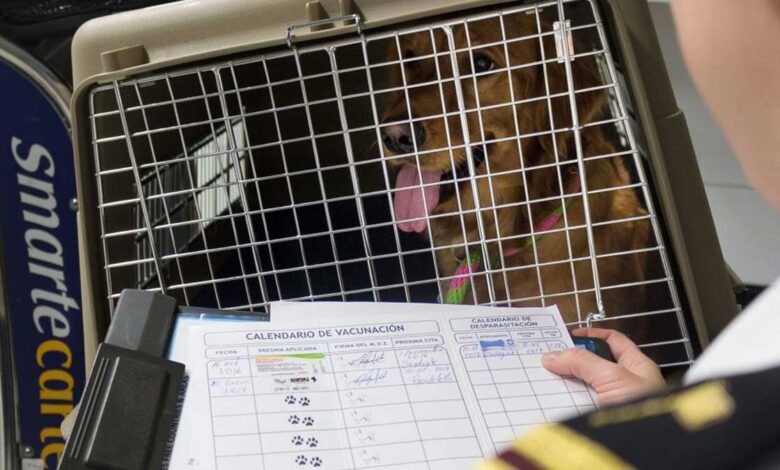

For the first time in nearly 70 years, the U.S. Centers for Disease Control and Prevention is proposing a change in how dogs are imported into the United States.Revisiting guidelines last revised in 1956, the proposed updates introduce a new set of requirements for people looking to bring in pets from countries with a high risk for rabies. The CDC says that dog rabies was eliminated in the United States in 2007, but the virus is still endemic in over 100 countries."The proposed updates aim to protect the public's health by preventing the reintroduction of dog rabies into the United States," CDC spokesperson David Daigle said. "These updates would establish an importation system designed to reduce fraud and improve the U.S. government's ability to verify that imported dogs have met U.S. entry requirements."In the video player above: In 2021, the CDC issued a temporary suspension of dog imports from over 100 countriesAlthough rabies among humans is rare in the United States, the virus kills about 59,000 people around the world each year, most of them children bitten by dogs, according to the CDC. Exposure to infected dogs causes 99% of human rabies deaths worldwide.After entering the body – usually via the bite of an infected animal – the virus travels through the nerves to the brain, where it multiplies and causes inflammation. By the time it reaches the brain and symptoms appear, the disease is usually fatal.The CDC's proposed regulation creates additional safeguards to prevent rabies from arriving from overseas. For instance, dogs from rabies-free or "low-risk" countries would be allowed to enter with written documentation that the dog has lived in the low-risk setting for the past six months.For dogs who were vaccinated in the U.S. and are returning from countries with high rabies incidence, their owners would be required to bring them to an airport with a CDC quarantine station. They would also need to have a rabies vaccination form completed and signed by a veterinarian approved by the U.S. Department of Agriculture.The proposed updates place the most restrictions on people seeking to import dogs from high-risk countries who have also been vaccinated abroad.In those situations, owners would need to have a valid rabies vaccination form completed by a licensed veterinarian and signed by an official government veterinarian of the exporting country. Once in the U.S., the dogs would have to be examined and revaccinated at a CDC-registered animal care facility.The CDC has opened the guidelines to public comment online until Sept. 8.Although the policy that the CDC hopes to update includes rules for dog and cat importation, cats are not required to have proof of rabies vaccination, and the CDC's changes don't affect cat imports.Rabies can be a particularly expensive virus to treat. According to the guidelines, the importation of an infected dog in 2019 cost state governments over $400,000 to investigate and administer post-exposure prophylaxis treatment.The updates come on the heels of the CDC's decision to extend its temporary suspension of dog imports from over 100 countries with a high rabies risk until July 31, 2024. The suspension began in 2021 after cases of imported dog rabies and a 52% uptick in falsified rabies vaccination certificates.Stretched thin due to the Covid-19 pandemic, the agency opted to suspend the arrival of dogs who had traveled to one of 113 countries considered at high risk for dog rabies, including Brazil, China and India.In addition to the more stringent vaccination verification and screening efforts, the proposed updates require that all dogs entering the U.S. be microchipped, at least 6 months old and healthy upon arrival.However, the proposed restrictions face challenges.In a statement Monday, the animal rights advocacy group Animal Wellness Action decried the agency's proposal as "draconian," saying the guidelines "will put Americans overseas at risk of losing their animals" and could "terribly complicate" US charities working with dogs abroad.In 2021, a letter signed by 57 U.S. representatives also called on the CDC to lift its suspension of canine imports from high-risk countries, describing the policy as a "one-size-fits-all approach" that "prevents thousands of dogs from … being rescued and adopted."But the CDC insists that its proposal is critical to preventing the re-emergence of rabies."We understand the important role pets play in our lives and that there are many health benefits to owning a pet," Daigle said. "However, the close relationships between dogs and people means there is a direct public health risk to people who interact with inadequately vaccinated dogs imported from countries with high risk for dog rabies."
For the first time in nearly 70 years, the U.S. Centers for Disease Control and Prevention is proposing a change in how dogs are imported into the United States.
Revisiting guidelines last revised in 1956, the proposed updates introduce a new set of requirements for people looking to bring in pets from countries with a high risk for rabies. The CDC says that dog rabies was eliminated in the United States in 2007, but the virus is still endemic in over 100 countries.
"The proposed updates aim to protect the public's health by preventing the reintroduction of dog rabies into the United States," CDC spokesperson David Daigle said. "These updates would establish an importation system designed to reduce fraud and improve the U.S. government's ability to verify that imported dogs have met U.S. entry requirements."
In the video player above: In 2021, the CDC issued a temporary suspension of dog imports from over 100 countries
Although rabies among humans is rare in the United States, the virus kills about 59,000 people around the world each year, most of them children bitten by dogs, according to the CDC. Exposure to infected dogs causes 99% of human rabies deaths worldwide.
After entering the body – usually via the bite of an infected animal – the virus travels through the nerves to the brain, where it multiplies and causes inflammation. By the time it reaches the brain and symptoms appear, the disease is usually fatal.
The CDC's proposed regulation creates additional safeguards to prevent rabies from arriving from overseas. For instance, dogs from rabies-free or "low-risk" countries would be allowed to enter with written documentation that the dog has lived in the low-risk setting for the past six months.
For dogs who were vaccinated in the U.S. and are returning from countries with high rabies incidence, their owners would be required to bring them to an airport with a CDC quarantine station. They would also need to have a rabies vaccination form completed and signed by a veterinarian approved by the U.S. Department of Agriculture.
The proposed updates place the most restrictions on people seeking to import dogs from high-risk countries who have also been vaccinated abroad.
In those situations, owners would need to have a valid rabies vaccination form completed by a licensed veterinarian and signed by an official government veterinarian of the exporting country. Once in the U.S., the dogs would have to be examined and revaccinated at a CDC-registered animal care facility.
The CDC has opened the guidelines to public comment online until Sept. 8.
Although the policy that the CDC hopes to update includes rules for dog and cat importation, cats are not required to have proof of rabies vaccination, and the CDC's changes don't affect cat imports.
Rabies can be a particularly expensive virus to treat. According to the guidelines, the importation of an infected dog in 2019 cost state governments over $400,000 to investigate and administer post-exposure prophylaxis treatment.
The updates come on the heels of the CDC's decision to extend its temporary suspension of dog imports from over 100 countries with a high rabies risk until July 31, 2024. The suspension began in 2021 after cases of imported dog rabies and a 52% uptick in falsified rabies vaccination certificates.
Stretched thin due to the Covid-19 pandemic, the agency opted to suspend the arrival of dogs who had traveled to one of 113 countries considered at high risk for dog rabies, including Brazil, China and India.
In addition to the more stringent vaccination verification and screening efforts, the proposed updates require that all dogs entering the U.S. be microchipped, at least 6 months old and healthy upon arrival.
However, the proposed restrictions face challenges.
In a statement Monday, the animal rights advocacy group Animal Wellness Action decried the agency's proposal as "draconian," saying the guidelines "will put Americans overseas at risk of losing their animals" and could "terribly complicate" US charities working with dogs abroad.
In 2021, a letter signed by 57 U.S. representatives also called on the CDC to lift its suspension of canine imports from high-risk countries, describing the policy as a "one-size-fits-all approach" that "prevents thousands of dogs from … being rescued and adopted."
But the CDC insists that its proposal is critical to preventing the re-emergence of rabies.
"We understand the important role pets play in our lives and that there are many health benefits to owning a pet," Daigle said. "However, the close relationships between dogs and people means there is a direct public health risk to people who interact with inadequately vaccinated dogs imported from countries with high risk for dog rabies."
Source link








